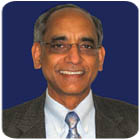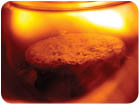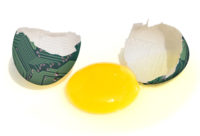
Arcing and uneven heating are two issues that have limited industrial applications of microwave technology, be it in food or any other manufacturing process. Researchers in Dana Corp.'s Disruptive Technologies Group in Rochester Hills, MI, believe they have overcome those limitations with atmospheric plasma technology-AtmoPlas for short. Toledo, OH-based Dana fabricates automotive parts in energy-intensive sintering furnaces operating at temperatures exceeding 2,000°F. Atmospheric plasma can reduce energy costs because of its efficiency and faster cycle times-extreme temperatures are attained in seconds.
The auto aftermarket business seems an unlikely source of food technology, but Dana executives are pursuing licensing deals that could bring microwave-absorbing plasma and 95 percent efficient microwave heating to food preparation. Semi-conductive nanoparticles are used to ignite the plasma, or gas, which absorbs and focuses the microwaves, reducing arcing and evenly distributing the heat. Plasma is maintained without vacuum, reducing complexity and expense.
Devendra Kumar and his younger brother, Satyendra, are listed as the inventors of plasma-assisted joining, the first patent issued for the core technology. Both are physicists; Satyendra's PhD is in material science, while Devendra's doctorate concentrated in the field of microwave spectroscopy. His graduate and undergraduate degrees were earned at India's Delhi University, where he also taught physics before emigrating to the US to carry out research involving lasers, DC and RF plasmas and photoacoustic and optogalvanic techniques at Louisiana State University in Baton Rouge. Devendra was director of LSU's molecular spectroscopy group when brother Satyendra lured him to Rochester Hills eight years ago to begin work on the microwave and plasma technology.
FE:Why did an automotive parts manufacturer underwrite development of microwave-heating technology?
Kumar: Dana Corp. does a lot of metal-to-metal joining, fabricating millions of parts per year with different alloys to make a stronger joint. One issue we have is the high cost of energy. Processes require huge furnaces that operate constantly and emit carbon dioxide and other exhaust gases that are an issue. When they decided to pursue microwave, I said, "It doesn't make sense, how can you use microwave to heat metal?" After all, microwave creates high voltages in metal, and even if the material isn't affected, reflected energy can destroy the magnetron.
A solution would be to conduct the thermal process in a chamber made of ceramic material that absorbs very little energy at room temperature. Unfortunately, it would take 20 to 30 minutes to heat ceramic to 1,100°C (2,012°F), and we could not afford to wait 30 minutes. We came up with a simple trick using a low-power microwave system to heat plasma in a small cavity. The air in the cavity is displaced, preferably with argon, though you could use nitrogen or another inert gas. Using a plasma catalyst, the plasma is heated to a very high temperature almost instantly. The conversion of energy to thermal heat is at least 95 percent efficient.

Kumar: The plasma is a gas; a flame is also a form of plasma. It's totally different from plasma in medical terminology. We're talking about a hot gas with some free atom or ionized molecule, such as the gas found in a fluorescent tube.
Plasma also is known as the fourth state of matter, distinct from solids, gases and liquids. It contains both electric and magnetic fields. The absorption of energy can be quite efficient. We only heat the plasma around the part or object being thermally treated, which further reduces the heat-transfer inefficiencies in conventional furnaces and ovens.
FE: Why do you need a plasma catalyst?
Kumar: If you were using high microwave power, you could ignite any gas without a catalyst. However, we use low-power magnetrons, and starting material is needed to create the chain reaction necessary to get ignition at a much lower temperature. We can use any particle capable of transferring enough energy to a gaseous atom or molecule to remove at least one electron in the presence of electromagnetic radiation. The exact catalyst is proprietary.
FE: Uniform heating is a problem with microwave cooking. How does atmospheric plasma address this?
Kumar: In a metallic box, microwaves bounce off the walls and form a standard wave pattern. It's like ripples on the surface of water. Because of the reflection of the wave, uniform intensity is prevented, and hot and cold spots result. With the plasma process, we can use three or more low-power magnetrons to feed the energy. And because the plasma absorbs the energy, one magnetron will not kill the others. Each magnetron produces its own standard wave pattern for uniform heating. Equipment cost also is much lower: a 6 kW magnetron retails for about $2,700. Six 1 kW magnetrons retail for $200 or $300 and cost much less when purchased in bulk. We've done tests with 2.45 GHz magnetrons, which are the same as those in home microwave ovens.
FE: Cooking food requires heat many magnitudes lower than a sintering furnace. Does that negate plasma's advantages?
Kumar: Temperature is more a function of how much microwave energy you're feeding into the chamber. The reaction of the plasma is very similar to a grill, which cooks from the outside. At the same time, microwaves are cooking from the inside. The combination gives us faster, better heating.
Two years ago, when we began considering the application of this technology to meat, someone asked if we could cook a hamburger that was rare on the inside and well done on the outside. I thought he was joking, but we found that by balancing the energy in the flame and the microwave, we can achieve a different degree of heat on the inside and outside. I happen to be a vegetarian, but in terms of appearance, color, texture and, I'm told, flavor, this technology produces a very appealing hamburger, and does it much faster than microwave alone. A 4-oz. burger is cooked in 50 seconds, compared to two to three minutes with a standard microwave, and it looks good. With a standard microwave, it doesn't look good; therefore, it doesn't taste good.
FE: Why was argon used in the heat chamber?
Kumar: Argon has two benefits. First, it's a monatomic gas, so there's no vibration or rotational molecular activity, which makes it easier to ignite the plasma. Second, if you're not cooking with oxygen, you're not cooking with flames, and this may result in healthier food. This is something we still have to establish, but there's a distinct possibility that the carcinogenic compounds that are formed from fat when cooking with oxygen can be reduced substantially.
We sent hamburgers cooked on a grill, in a standard microwave and by atmospheric plasma to a certified food lab for analysis. In terms of carcinogens, ten chemicals were analyzed, and this method was no worse than the others. In terms of nutrition, atmospheric plasma was as good as the others, but it by far was the shortest cooking time, with a crispy exterior and a wonderful texture and appearance.
FE: The heat chamber is described as having a cross-sectional dimension greater than lambda/4, where lambda is the wavelength of the radiation. Explain the role of chamber dimension.
Kumar: The cavity shape allows us to manipulate the effect of both the microwave and the flame. The closer the wall of the cavity is to the object being heated, the thinner the layer of plasma. To achieve more flame cooking and less microwave cooking, the space is increased. If only microwave cooking is desired, the object is abutted to the side of the cavity.
The microwave source can be pulsed, where the on time is much shorter than the off time. Low-duty time pulses give great control in cooking, with the actual temperature a balance between the amount of energy inputted and the heat lost. Frequency and power dictate efficiency, and the efficiency of this technology is much higher than standard microwave.
FE: Dana Corp. licensed the technology for the manufacture of carburizing systems and for use in nitriding processes. How close are you to a food-application deal?
Kumar: We're talking to food equipment manufacturers about building a system. First, we'll take the time to standardize the equipment and the process. This technology has fairly wide applications, and we're talking to people about its use in a variety of applications.
The first patent was issued in March 2005. It was for microwave joining and was one of 23 original patent filings. Since then, we've filed several more applications.


